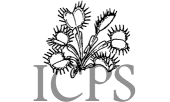|
Carnivorous Plant Newsletter
Volume 45, Number 4, December 2016, pages 158 - 163
New Cultivars
Heliamphora ‘Red Mambo’
Sarracenia ‘Cancan’
Sarracenia ‘Whale Tail’
Pinguicula ‘Niklas’
Pinguicula ‘Red Starfish’
Heliamphora ‘Red Mambo’
Submitted: 19 September 2016.
I found this amazing and very elegant plant in a private collection, years ago. The label was missing, but the morphology of the nectar spoon and the woody stem clearly show, in my opinion, an influence of Heliamphora heterodoxa and H. tatei (Fig. 1).
I tried to produce seeds three times, under different growing conditions, but each attempt failed, so the plant is maybe sterile. The flower stalks are about 50 cm tall. It is a very slow grower, but vegetative propagation by rhizome cutting or division is quite easy, and the only method to keep the unique morphology.
The mature pitchers stand 18 cm or taller, colored green with red edges and veins. The pitcher outside is completely bald; the inside has a short white fuzz. The neck under the nectar spoon is fire red under good lighting.
The nectar spoon is very unique. Fully developed (under massive lighting of four 24w 6400k T5 fs), the nectar spoon is 1 cm long and about 0.3 cm wide. With a fire red “conquistador helmet” style, the nectar spoon also has a horned ending, pointing to the sky.
The name ‘Red Mambo’ came from the from the nectar spoon color and shape which reminds me of the very graceful mambo dance with wide movements.
— François Boulianne • Montréal • Quebec • Canada • dallas@dallasmail.com
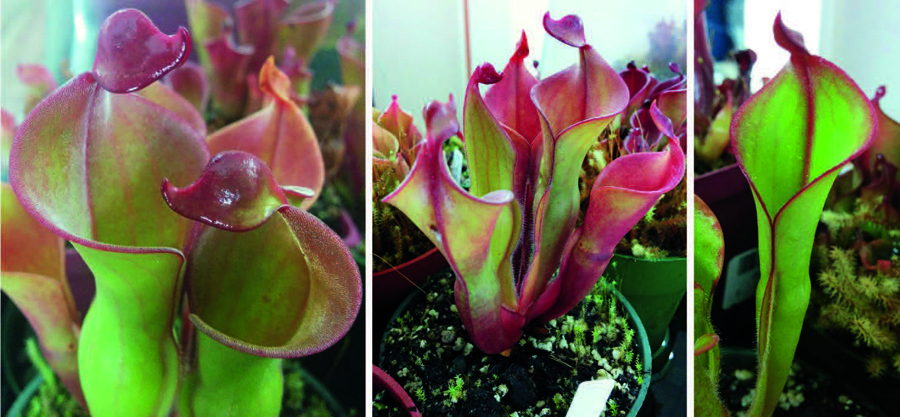
Figure 1: Heliamphora ‘Red Mambo’.
Sarracenia ‘Cancan’
Submitted: 29 July 2016
Sarracenia ‘Cancan’ (Fig. 2) was selected from the cross of S. (flava var. maxima × purpurea subsp. venosa) × flava var. atropurpurea performed in 2007. The maternal clone was S. flava var. maxima × purpurea subsp. venosa, a robust, big-lipped clone exhibiting terracotta red coloration with inverted yellow veins. The paternal clone has a large red ruffled lid and is believed by some authors not to be a true S. flava var. atropurpurea, but rather a complex artificial hybrid.
The seedling population gained from this cross demonstrated great color variability. One of the seedlings was selected due to an exceptionally intensive, all red coloration. It also belonged to the strongest seedlings in the population. Later on it became apparent that this clone exhibited an irregular shape of the pitchers, including twisted lids. This feature is usually considered a negative character and such plants are eliminated in our collection. Reaching maturity, the plant demonstrated high number of pitchers, exceptional robustness, and overall beauty that was considered exceptional by many visitors of our nursery. Therefore we decided to establish this unique plant as a cultivar.
Sarracenia ‘Cancan’ is 20-25 cm tall, the peristome is 4-6 cm wide, the lid 8-11 cm wide. Mature plants produce 5-8 pitchers on one growing point, typically 7. Flowers are red-orange with yellow-green umbrella. The overall shape of the flower is globose, size 6-7 cm. S. ‘Cancan’ is well fertile, the capsule contains usually 200-300 moderately sized, viable seeds. Root system of S. ‘Cancan’ is exceptionally rich, making the plants very well fixed in their pots. Also rhizome offshoots start producing their own roots readily, making vegetative propagation of this clone more effective. All means of vegetative propagation are suitable for maintaining features of this described cultivar that was named according to the look of dancers of French dance Cancan.
— Miroslav Srba • Mokra • Czech Republic • srba@sarracenia.cz
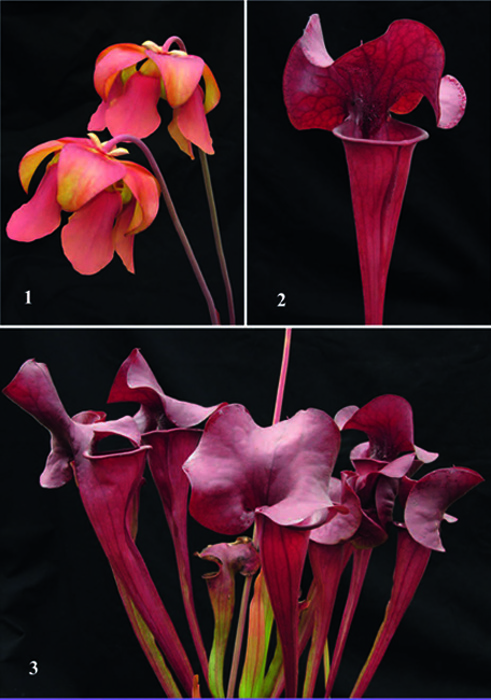
Figure 2: Sarracenia ‘Cancan’. 1 flowers; 2 detail of the pitcher; 3 mature plant.
Sarracenia ‘Whale Tail’
Submitted: 29 July 2016
Hybrids between Sarracenia purpurea subsp. venosa and S. oreophila are well known to be very vigorous and produce robust pitchers with a huge lid. These hybrids are intermediate between the bulbous and erect type of Sarracenia, resembling habitus of S. × catesbaei. The aim of this cultivar cross was to obtain a short-pitchered hybrid with a large lid, but shifted to the elegant “flava/oreophila” shape. A backcross hybrid Sarracenia purpurea subsp. venosa × (flava × purpurea) was used as the seed plant instead of the botanical S. purpurea subsp. venosa in order to introduce a genetic portion of S. flava. This hybrid was pollinated with S. oreophila in May 2002. Unfortunately only 2 seeds were produced, but only one of them germinated. Selection of the best seedling was groundless therefore. Surprisingly the single seedling fulfilled all expectations.
Sarracenia ‘Whale Tail’ (Fig. 3) has red-orange pitchers shaped somewhat like a shortened S. flava. The traps are very robust and keep a height:lid size ratio 3:1. The length of pitchers in mature plants is usually 30 cm and width of the lid is 10 cm. The record pitcher observed reached 42 cm with a 14 cm broad lid. Due to the silhouette dominated by the enormous lid, I decided to name this plant Sarracenia ‘Whale Tail’ as it resembles the tail fin of whales emerging above the sea level. The pitchers are not durable and are lost during winter dormancy. Phyllodia typical for S. oreophila are formed very rarely in S. ‘Whale Tail’. However, the plant might form late autumn pitchers having a S. × catesbaei shape. The flower color is salmon. Petals are yellow marbled, eccentrically shaped. Diameter of the flower is 7-9 cm. Sarracenia ‘Whale Tail’ is a poor producer of seeds. Only few seeds are usually found in the capsule. The pollen is well viable. The root system of the plants is quite poor, similar to those in Sarracenia purpurea. The plant has a strong tendency to produce small, viable offshoots. This feature was the last point to decide register this plant as a cultivar as I believe it can quickly spread among all collectors who are interested. All vegetative means of propagation are suitable for maintaining of all characteristics of Sarracenia ‘Whale Tail’.
— Miroslav Srba • Mokra • Czech Republic • srba@sarracenia.cz
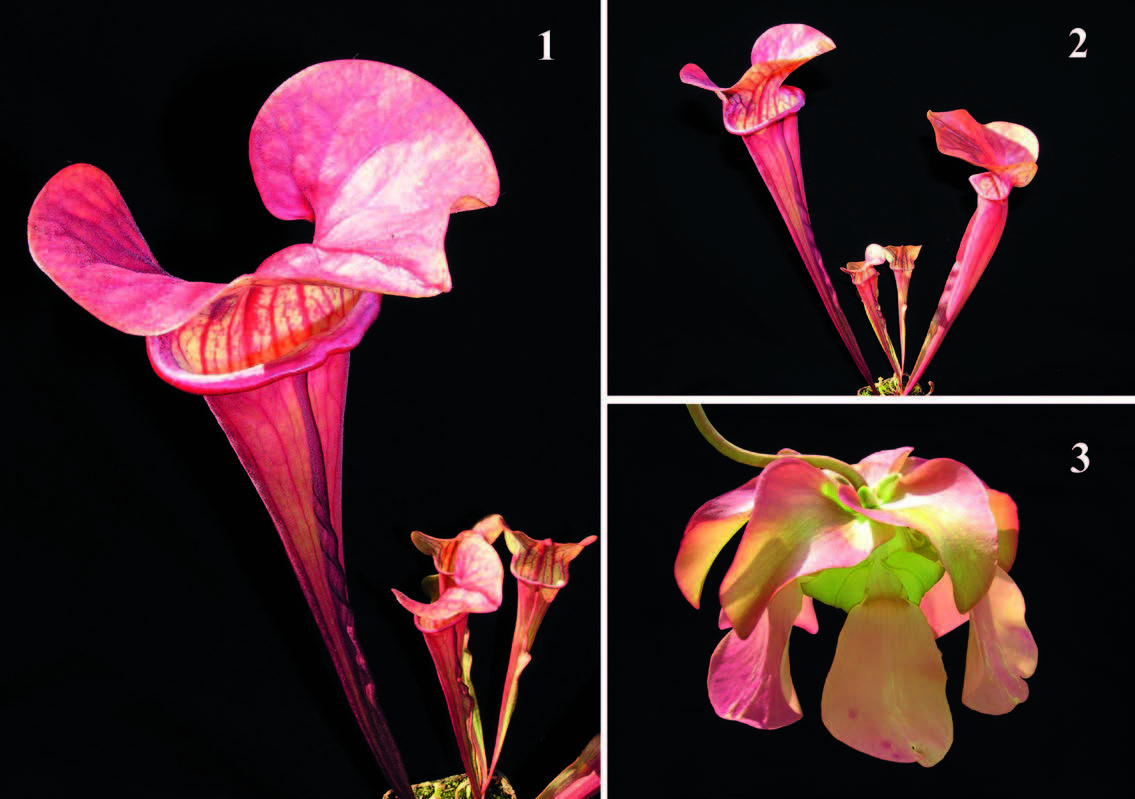
Figure 3: Sarracenia ‘Whale Tail’. 1 mature plant; 2 detail of the pitcher; 3 flower.
Pinguicula ‘Niklas’
Submitted: 15 July 2016
After having registered my cultivar Pinguicula ‘Florian’ more than 10 years ago, I still wanted to create a second cultivar and name it Pinguicula ‘Niklas’ after my second child, Niklas. For that, in 2014 I crossed Pinguicula moranensis from Sumidero Canyon (clone 1) with Pinguicula emarginata with dark violet veined flowers. A year later I could already see the result of that crossing and I was satisfied with the outcome combining characters of both species in this new cultivar.
The cultivar forms a winter and a summer rosette. The winter rosette consists of 10-15 succulent obovate-spathulate leaves, slightly pointed at the tip, glabrous, of a light green color, 9-12 mm long and 5-7 mm at the widest point. The summer rosette (Fig. 4) consists of 7-9 leaves, obovate-spathulate, with the margin involute, light yellow-green to red-green (depending on light conditions), 25-37 mm long, 15-20 mm at the widest point, the upper surface densely covered with sessile and stipitate hairs.
Flowers are produced out of the summer rosette, with 1-3 flower scapes per season, erect, 70-75 mm long, olive or olive-red, densely covered with stipitate glandular hairs. Flowers are about 25 mm long (including the spur), the corolla is about 2 cm in diameter (Fig. 4). The calyx bilabiate, red-brown, with calyx lobes cuneate-linear, 2.5-3 mm long and 1-1.5 mm wide, rounded or obtuse at the tip, the outer surface sparsely clothed in stipitate glandular hairs. The corolla consists of two lips. The 2 lobes of the upper lip are truncate with the end of the lobe slightly incised. Corolla lobes are of a purple-violet color with fine, darker violet venation. The lobes of the upper lip are 9-10 mm long, 6 mm at the widest point, side lobes of the lower lip 9-10 mm long, 6-7 mm at the widest point, middle lobe of the lower lip 13-15 mm long, 9-10 mm at the widest point. The spur is of a light green color, about 17-18 mm long, in the middle slightly thicker, obtuse at the end and densely covered with stipitate glandular hairs.
Pinguicula ‘Niklas’ must be reproduced vegetatively to preserve the unique characteristics of this cultivar.
— Oliver Gluch • Harthausen • Germany • oliver@gluch.info
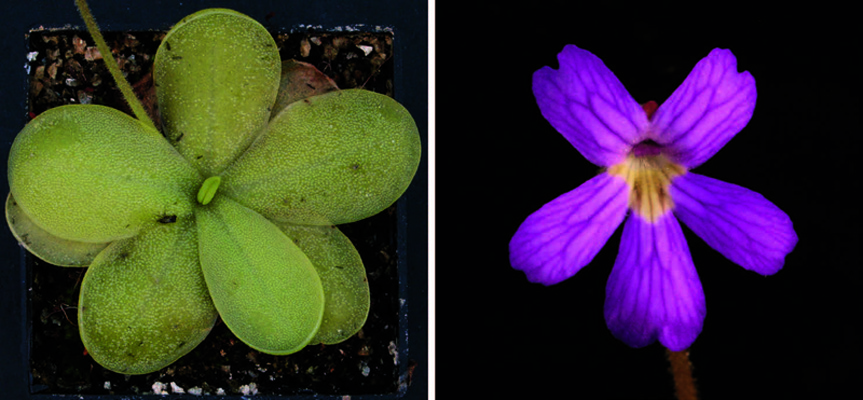
Figure 4: Pinguicula ‘Niklas’ summer rosette and flower.
Pinguicula ‘Red Starfish’
Submitted: 29 July 2016
Pinguicula ‘Red Starfish’ (Fig. 5 and Back Cover) provides an unusual look that is much more “carnivorous” compared to other Pinguicula species or established cultivars. As the plant resemble dangerous predator of tropical coral reefs, we decided to name the new cultivar Pinguicula ‘Red Starfish’. This plant originated in Botanical garden of Liberec (Czech Republic) in 1994 as a cross between red leaved Pinguicula moranensis and Pinguicula heterophylla. This clone was selected in 1997 with a special emphasis on the flower color.
Summer leaf rosette is usually 6-9 cm in diameter and consists of 12-20 leaves. Leaves are lanceolate, rolled downwards in lateral as well as in tangential direction. Well-illuminated plants turn into a red-purple coloration. Winter rosette is bulbous, predominantly submerged, and similar to P. heterophylla. Winter “bulb” of juvenile plants is fusiform, in mature plants almost globose, consisting of 40-70 leaves. Pinguicula ‘Red Starfish’ flowers in the beginning of the vegetative season, just after waking from the dormant period. Flowers are sterile. Corolla is dark blue-purple, resembling P. heterophylla in shape. Petals are slightly twisted. Size of the flowers is 18-22 mm. Spoon is straight, about 20 mm long. Flower stalk is 9-13 cm tall.
Sufficient growth conditions for Pinguicula ‘Red Starfish’ are the same as in other Mexican Pinguicula species strictly undergoing dry winter dormancy like e.g. Pinguiculagypsicola, P. heterophylla , or P. medusina. Although it doesn’t exhibit any specific growing requirements, we would like to provide several tips to optimize growth of this cultivar. During the first years of our experience, it seemed that P. ‘Red Starfish’ is not very floriferous. Later we realized, that the growth period of this clone is very long, lasting until November or even December in conditions of central Europe. If the growth activity is rapidly interrupted by low temperatures or rapid drought, the fitness of dormant plants is significantly decreased. On the other hand, if mild temperatures (8-18°C) and slightly wet soil is provided during the phenophase transition (beginning of dormancy), the winter bulbs get much stronger. Specimens that formed bulb at least 10 mm wide bloom regularly with 1-3 flowers.
Propagation is possible only by vegetative means, especially by winter (bulb) leaf cuttings. We recommend to lay these cuttings carefully in a small furrow formed e.g. tip of tweezers. Cuttings that are comfortably seated in such a depression start formation of a new plantlet quickly. 20-30 new plants can be obtained from a single adult specimen of P. ‘Red Starfish’. Authors also established viable tissue culture of this clone to provide specimens of Pinguicula ‘Red Starfish’ to all collectors who would like to enjoy this unusual cultivar.
— Miroslav Srba • Mokra • Czech Republic • srba@sarracenia.cz
— Miloslav Studnička • Botanic Gardens Liberec • Liberec • Czech Republic
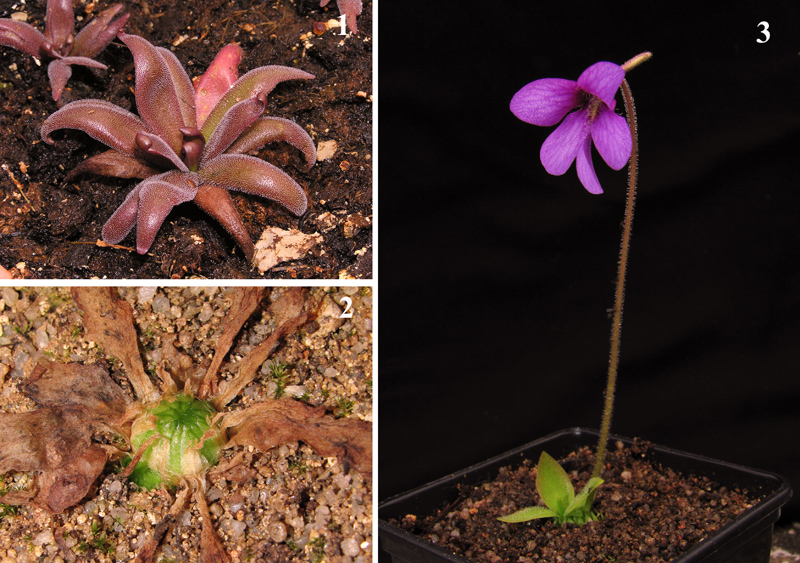
Figure 5: Pinguicula ‘Red Starfish’. 1 summer rosette; 2 winter rosette (bulb); 3 flowering plant.

Back Cover: Pinguicula ‘Red Starfish’ summer rosette and flower (inset). This newly
named cultivar was created by Dr. Miloslav Studnicka in 1994. Photo by Miroslav Srba.
|
